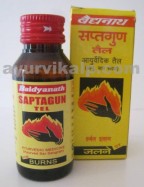Burns, which can range from minor to severe, require careful management to prevent infection, reduce pain, and promote healing. Ayurveda offers a holistic approach to treating burns by using natural remedies that soothe, heal, and rejuvenate the skin. Here's a detailed overview of Ayurvedic medicines and practices for managing burns, tailored for an audience in the United States:
Ayurvedic Understanding of Burns
In Ayurveda, burns are classified based on the severity and depth of the injury, similar to modern medicine's classification of first, second, and third-degree burns. Burns primarily involve an imbalance in the Pitta dosha, which governs heat and inflammation in the body. The treatment focuses on cooling the affected area, reducing inflammation, and promoting tissue regeneration.
Ayurvedic Medicines and Remedies
1. Aloe Vera (Ghritkumari)
-
Benefits: Aloe Vera has soothing, anti-inflammatory, and healing properties, making it highly effective for treating burns.
-
Usage: Apply fresh Aloe Vera gel directly to the burn. It can be used several times a day to cool and heal the skin.
2. Turmeric (Curcuma longa)
-
Benefits: Turmeric has antiseptic and anti-inflammatory properties that help prevent infection and reduce inflammation.
-
Usage: Mix turmeric powder with water or Aloe Vera gel to form a paste and apply it to the burn.
3. Honey
-
Benefits: Honey has natural antibacterial properties and promotes healing by keeping the burn moist and preventing infection.
-
Usage: Apply a thin layer of honey to the burn and cover it with a sterile bandage. Change the dressing and reapply honey daily.
4. Coconut Oil
-
Benefits: Coconut oil helps in moisturizing and soothing the skin while promoting healing and preventing scarring.
-
Usage: Apply a thin layer of coconut oil to the burn once the initial heat and inflammation have subsided.
5. Sandalwood (Chandan)
-
Benefits: Sandalwood has cooling properties that help reduce burning sensations and promote healing.
-
Usage: Mix sandalwood powder with rose water to create a paste and apply it to the burn.
6. Calendula (Marigold)
-
Benefits: Calendula has anti-inflammatory and healing properties that can speed up the healing process.
-
Usage: Use calendula ointment or make a poultice with calendula flowers and apply it to the burn.
Dietary Recommendations
Ayurveda emphasizes the importance of diet in managing burns:
-
Cooling Foods: Consume cooling foods such as cucumbers, melons, and leafy greens to help balance the Pitta dosha.
-
Hydration: Drink plenty of water, coconut water, and herbal teas to stay hydrated and support healing.
-
Anti-Inflammatory Foods: Include anti-inflammatory foods like turmeric, ginger, and green leafy vegetables in your diet.
-
Avoid Spicy and Fried Foods: Reduce intake of spicy, oily, and fried foods that can aggravate Pitta and increase inflammation.
Lifestyle and Practices
1. Cold Compresses
-
Practice: Apply cold compresses or cool water to the burn immediately after injury to reduce heat and inflammation.
-
Benefits: Helps to alleviate pain and prevent further tissue damage.
2. Gentle Cleaning
-
Practice: Clean the burn gently with cool water and mild, natural soap to prevent infection.
-
Benefits: Reduces the risk of infection and promotes healing.
3. Meditation and Stress Reduction
-
Practice: Engage in meditation and stress-reducing techniques to promote overall well-being and support the healing process.
-
Benefits: Reduces stress-induced inflammation and supports recovery.
Integration into the United States
Ayurvedic practices and products are becoming more popular in the United States as a complementary approach to conventional burn treatments. Many wellness centers and holistic health practitioners offer Ayurvedic consultations and treatments. Ayurvedic products are also widely available in health stores and online, making it easier for individuals to incorporate these remedies into their daily routine.
Precautions
-
Consult Healthcare Providers: For severe burns or if there are signs of infection, seek immediate medical attention from a healthcare provider. Ayurvedic treatments can be used in conjunction with conventional treatments for better outcomes.
-
Quality of Herbs: Use high-quality, organic herbs and products to ensure safety and efficacy.
-
Patch Test: Before applying any herbal remedy, perform a patch test to check for allergic reactions.
Conclusion
Ayurveda offers a holistic approach to managing burns through natural remedies, dietary adjustments, and lifestyle practices. These treatments aim to cool the affected area, reduce inflammation, and promote healing. By integrating these practices with modern healthcare, individuals can achieve effective management of burns and improve their quality of life. With the growing acceptance of Ayurvedic medicine in the United States, these natural treatments offer a valuable option for those seeking effective and holistic solutions for burn care.










